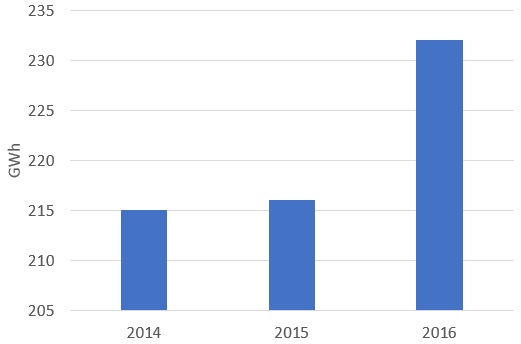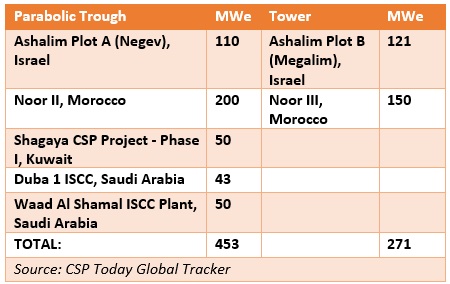Dubai CSP developers urged to apply Shams 1 desert findings
The developer of Dubai's first CSP tower project can learn from design modifications on the Shams 1 parabolic trough plant which minimized the impact of desert weather and raised revenues during the ramp-up phase, Abdulaziz Alobaidli, general manager of Shams Power Company told New Energy Update.

Related Articles
The Dubai Electricity and Water Authority (DEWA) is to select the developer for a 200 MW CSP tower plant later this year after receiving bids from four international consortia. The minimum bid price was $94.50/MWh, according to local media reports.
As the first CSP tower project in the United Arab Emirates (U.A.E.), the successful bidder will need to implement lessons learned in similar desert environments to control costs and maximize revenues.
The 100 MW Shams 1 parabolic trough plant in Abu Dhabi has exceeded production expectations in the first five years of operations, despite challenging desert conditions including sandstorms and wind speeds of up to 126 km/h. The Shams Power Company is 80%-owned by Masdar and 20%-held by Total. Masdar is also leading a bid for Dubai’s first CSP tower plant.
CSP developers are being urged to improve plant performance in the ramp up years to lower the risk margins which impact competitiveness.
The Shams 1 plant achieved a 99.5% reliability rate in 2016 and generated a total of 232 GWh, some 9% above expected output levels, Alobaidli told New Energy Update.
Output at Shams 1 was boosted by modifications during the initial production phases which reduced morning start-up times, Alobaidli said.
“When we started operating Shams 1 it took us two hours to start up the plant.... Today it takes one hour and sometimes less,” he said.
Modifications included a pre-warming line to extract steam from the turbine to warm the plant, Alobaidli said.
“We utilize the steam in the system to pre-warm the plant and avoid having a big difference between the hot and cold status of the plant later. You must keep the solar-field and steam cycles as close to each other as possible in terms of temperature,” he said.
Shams 1 annual output

Data source: Shams Power Company
The Shams Power Company also improved plant reliability by erecting a perimeter wind fence to protect components from high wind levels and shifting dust. The fence protects the parabolic troughs from wind gusts and prevents the persistent movement of sand which can enter the solar field and cover components.
A similar fence at DEWA's planned CSP tower project would protect heliostats from performance degradation.
“I think a wind fence will be needed because it has huge benefits to the plant,” Alobaidli said.
“Distances in tower plants can reach two kilometres whereas in trough plants they do not exceed three metres. So, the dust impact is much bigger on tower technology,” he said.
Shams Power Company is also currently testing a modification to cleaning trucks to make them more efficient and reduce water consumption.
“We’re planning to pilot this modification in one of our cleaning trucks in 2017 and if the results are positive we will upgrade our trucks in 2018,” Alobaidli said.
CSP plants under construction in the Middle East

Desert designs
Innovative heliostat designs, smart software, and pre-assembly installation methods are helping to reduce the cost of CSP towers.
DEWA has specified that its first CSP plant must have a minimum of eight hours storage and the utility has tendered for a pair of 100 MW towers as this layout represents a cost-effective solution at this stage of global CSP development, Inaki Perez, Solar Team Leader at Mott MacDonald DEWA's Technical Advisor, said at the MENA New Energy 2017 conference in April.
DEWA’s tender specifications also provide design flexibility, allowing developers to optimize the solution within the tender requirements, Perez noted.
The attenuation of solar rays from heliostat to tower due to dust and aerosols is the "biggest technological challenge" for developers in the UAE, Georgio Akiki, Middle East business development manager at EPC contractor Sener, told the conference. Sener has been involved in 29 CSP plant projects globally and is a partner in one of the DEWA CSP tender bids.
More research is required into the impact of attenuation on plant performance so that companies can engineer ways to minimize the risks, Akiki said.
One option to reduce attenuation is to construct a higher density solar field closer to the tower but this layout would also need to minimize shading and blocking, he noted.
Going forward, design solutions to mitigate attenuation could change tower designs in the Middle East, Alobaidli said.
"The solution is to think about multi-tower technology, because this will reduce the distance between the heliostat and tower,” he said.
By Heba Hashem
